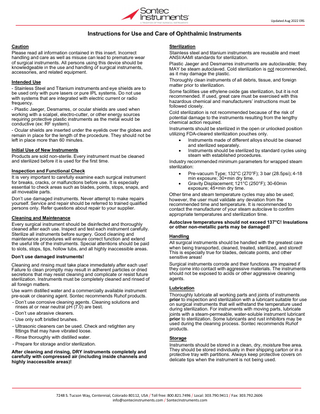Sontec Instruments
Ophthalmic Instruments Instructions for Use
1 Page

Preview
Page 1
Updated Aug 2022 ERS
Instructions for Use and Care of Ophthalmic Instruments Caution Please read all information contained in this insert. Incorrect handling and care as well as misuse can lead to premature wear of surgical instruments. All persons using this device should be knowledgeable in the use and handling of surgical instruments, accessories, and related equipment. Intended Use - Stainless Steel and Titanium instruments and eye shields are to be used only with pure lasers or pure IPL systems. Do not use with systems that are integrated with electric current or radio frequency. - Plastic Jaeger, Desmarres, or ocular shields are used when working with a scalpel, electro-cutter, or other energy sources requiring protective plastic instruments as the metal would be conductive (ex: RF system). - Ocular shields are inserted under the eyelids over the globes and remain in place for the length of the procedure. They should not be left in place more than 60 minutes. Initial Use of New Instruments Products are sold non-sterile. Every instrument must be cleaned and sterilized before it is used for the first time. Inspection and Functional Check It is very important to carefully examine each surgical instrument for breaks, cracks, or malfunctions before use. It is especially essential to check areas such as blades, points, stops, snaps, and all moveable parts. Don’t use damaged instruments. Never attempt to make repairs yourself. Service and repair should be referred to trained qualified persons only. Refer questions about repair to your supplier. Cleaning and Maintenance Every surgical instrument should be disinfected and thoroughly cleaned after each use. Inspect and test each instrument carefully. Sterilize all instruments before surgery. Good cleaning and maintenance procedures will ensure correct function and extend the useful life of the instruments. Special attentions should be paid to slots, stops, tips, hollow tubs, and all highly inaccessible areas. Don’t use damaged instruments! Cleaning and rinsing must take place immediately after each use! Failure to clean promptly may result in adherent particles or dried secretions that may resist cleaning and complicate or resist future sterilization. Instruments must be completely cleaned and rinsed of all foreign matters. Use warm distilled water and a commercially available instrument pre-soak or cleaning agent. Sontec recommends Ruhof products. - Don’t use corrosive cleaning agents. Cleaning solutions and rinses at or near neutral pH (7.0) are best. - Don’t use abrasive cleaners. - Use only soft bristled brushes. - Ultrasonic cleaners can be used. Check and retighten any fittings that may have vibrated loose. - Rinse thoroughly with distilled water. - Prepare for storage and/or sterilization. After cleaning and rinsing, DRY instruments completely and carefully with compressed air (including inside channels and highly inaccessible areas)!
Sterilization Stainless steel and titanium instruments are reusable and meet ANSI/AAMI standards for sterilization. Plastic Jaeger and Desmarres instruments are autoclavable; they MAY be steam autoclaved. Cold sterilization is not recommended, as it may damage the plastic. Thoroughly clean instruments of all debris, tissue, and foreign matter prior to sterilization. Some facilities use ethylene oxide gas sterilization, but it is not recommended. If used, great care must be exercised with this hazardous chemical and manufacturers’ instructions must be followed closely. Cold sterilization is not recommended because of the risk of potential damage to the instruments resulting from the lengthy chemical action required. Instruments should be sterilized in the open or unlocked position utilizing FDA-cleared sterilization pouches only. • Instruments made of different alloys should be cleaned and sterilized separately. • Instruments should be sterilized by standard cycles using steam with established procedures. Industry recommended minimum parameters for wrapped steam sterilization: • Pre-vacuum Type; 132°C (270°F); 3 bar (28.5psi); 4-18 min exposure; 30+min dry time. • Gravity Displacement; 121°C (250°F); 30-60min exposure; 45+min dry time. Other time and steam temperature cycles may also be used; however, the user must validate any deviation from the recommended time and temperature. It is recommended to contact the manufacturer of your steam autoclave to confirm appropriate temperatures and sterilization time. Autoclave temperatures should not exceed 137°C! Insulations or other non-metallic parts may be damaged! Handling All surgical instruments should be handled with the greatest care when being transported, cleaned, treated, sterilized, and stored! This is especially true for blades, delicate points, and other sensitive areas! Surgical instruments corrode and their functions are impaired if they come into contact with aggressive materials. The instruments should not be exposed to acids or other aggressive cleaning agents. Lubrication Thoroughly lubricate all working parts and joints of instruments prior to inspection and sterilization with a lubricant suitable for use on surgical instruments that will withstand the temperature used during sterilization. For instruments with moving parts, lubricate joints with a steam-permeable, water-soluble instrument lubricant prior to sterilization. Some lubricants and rust inhibitors may be used during the cleaning process. Sontec recommends Ruhof products. Storage Instruments should be stored in a clean, dry, moisture free area. They should be stored individually in their shipping carton or in a protective tray with partitions. Always keep protective covers on delicate tips when the instrument is not being used.
7248 S. Tucson Way, Centennial, Colorado 80112, USA / Toll free: 800.821.7496 / Local: 303.790.9411 / Fax: 303.792.2606 [email protected] / SontecInstruments.com